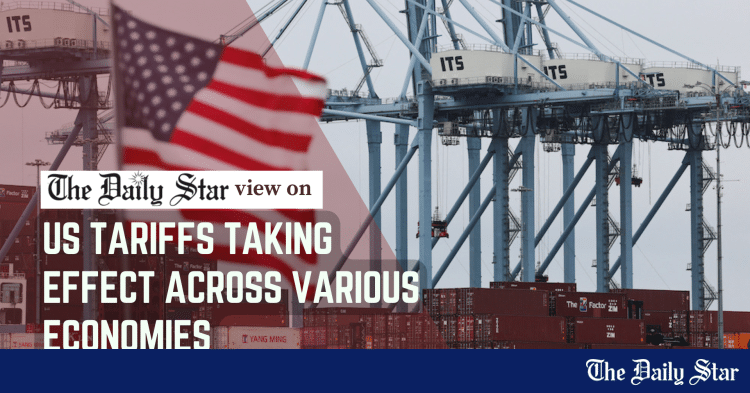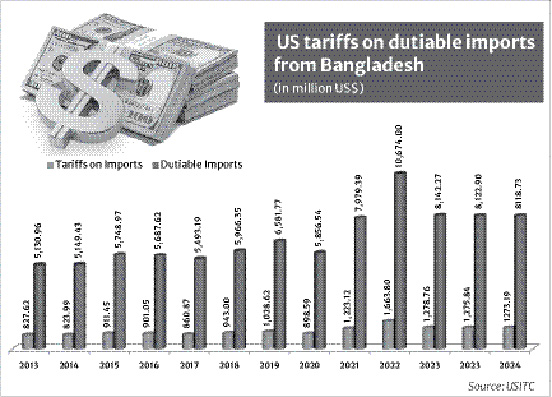Saif
Senior Member
- Joined
- Jan 24, 2024
- Messages
- 15,416
- Nation

- Axis Group


Tariff can be reduced by using US raw materials
The recently announced 20 per cent reciprocal tariff on Bangladeshi goods exported to the United States could be reduced further by using US raw materials, said business leader Mahmud Hasan Khan Babu...
 www.newagebd.net
www.newagebd.net
Tariff can be reduced by using US raw materials
BGMEA says
Staff Correspondent 03 August, 2025, 00:35

Bangladesh Garment Manufacturers and Exporters Association organises a press conference at the BGMEA Complex in the capital on Saturday to address the impact of US reciprocal tariff. | Press release
The recently announced 20 per cent reciprocal tariff on Bangladeshi goods exported to the United States could be reduced further by using US raw materials, said business leader Mahmud Hasan Khan Babu.
The president of the Bangladesh Garment Manufacturers and Exporters Association was addressing reporters during a press conference at the BGMEA Complex in the capital on Saturday, discussing the US reciprocal tariff.
‘According to the clause F of section 3 (pages 13 and 14) of the US Executive Order 14257 on reciprocal duty, if a product exported to the US contains 20 per cent or more US-origin contents (raw materials), the reciprocal tariff would not apply to that portion,’ he added.
For example, if an RMG item worth $100 contains 26 per cent US content, then the reciprocal tariff could only be imposed on the value of the remaining 74 per cent.
Babu said that if this provision could be utilised effectively, it would offer significant tariff relief for the exporters.
However, he said that the implementation process of this clause remains unclear.
‘It is not specified how this rule would be applied or through which mechanism. We need greater clarity on this from the US side,’ he added.
He also stated that they would discuss this with the US side and US Customs and Border Protection regarding the execution of this clause, including traceability, mechanisms, greater transparency, detailed guidance, and clarification.
He also stated that approximately 75 per cent of the readymade garment items exported to the US were made from cotton.
He also said that if they could obtain a tariff waiver, there would be no pressure to import more US cotton and synthetic fibres, as this, in turn, could bring the effective tariff down below 20 per cent.
He also said that the reduction in reciprocal tariff from 35 per cent to 20 per cent brought some relief for the Bangladeshi exporters.
‘However, we have no room for self-satisfaction as competitors like India, Vietnam, China, and Pakistan are unlikely to be idle. They will continue negotiations and lobbying, and at any point, their tariff rates may drop even further,’ he added.
‘The latest US executive order mentioned that trade or security agreement talks were still ongoing with several countries. Bangladesh must remain engaged in this diplomatic process,’ he said.
He also expressed concerns, saying that the buyers might now face additional financial pressure.
‘To purchase the same volume of goods, buyers would need to arrange for 20 per cent more capital,’ he noted, saying that if a buyer has that capacity, they would proceed, and if not, they might resort to bank loans.
And if they don’t qualify for loans, they could reduce the number of orders. That’s where the concern lies, he added.
Moreover, the additional duty burden could ultimately fall on the end consumers, and if consumers reduce their purchases in response to higher retail prices, that too could lead to a decline in order volumes.
‘However, we are hopeful the market won’t head in that direction. At least one full season will be needed to truly understand how this plays out,’ he added.
Responding a question from a journalist on who would bear the reciprocal tariff, he said that about 95 per cent of the RMG exports operate under the Free-on-Board model, where the buyer is responsible for all charges after shipment—including import duties.
‘So far, no buyer has explicitly said they won’t bear the cost of this new countervailing duty. Therefore, we are assuming they will cover it,’ he added.
However, he said that they don’t want to jump ahead and make assumptions, but if buyers wish to open a discussion, they are ready to engage.
He urged the government to provide sustained policy support to ensure the sector’s competitiveness concerning the NBR, customs, ports, and gas and electricity supply.
Members of the BGMEA board of directors were also present at the event.
BGMEA says
Staff Correspondent 03 August, 2025, 00:35
Bangladesh Garment Manufacturers and Exporters Association organises a press conference at the BGMEA Complex in the capital on Saturday to address the impact of US reciprocal tariff. | Press release
The recently announced 20 per cent reciprocal tariff on Bangladeshi goods exported to the United States could be reduced further by using US raw materials, said business leader Mahmud Hasan Khan Babu.
The president of the Bangladesh Garment Manufacturers and Exporters Association was addressing reporters during a press conference at the BGMEA Complex in the capital on Saturday, discussing the US reciprocal tariff.
‘According to the clause F of section 3 (pages 13 and 14) of the US Executive Order 14257 on reciprocal duty, if a product exported to the US contains 20 per cent or more US-origin contents (raw materials), the reciprocal tariff would not apply to that portion,’ he added.
For example, if an RMG item worth $100 contains 26 per cent US content, then the reciprocal tariff could only be imposed on the value of the remaining 74 per cent.
Babu said that if this provision could be utilised effectively, it would offer significant tariff relief for the exporters.
However, he said that the implementation process of this clause remains unclear.
‘It is not specified how this rule would be applied or through which mechanism. We need greater clarity on this from the US side,’ he added.
He also stated that they would discuss this with the US side and US Customs and Border Protection regarding the execution of this clause, including traceability, mechanisms, greater transparency, detailed guidance, and clarification.
He also stated that approximately 75 per cent of the readymade garment items exported to the US were made from cotton.
He also said that if they could obtain a tariff waiver, there would be no pressure to import more US cotton and synthetic fibres, as this, in turn, could bring the effective tariff down below 20 per cent.
He also said that the reduction in reciprocal tariff from 35 per cent to 20 per cent brought some relief for the Bangladeshi exporters.
‘However, we have no room for self-satisfaction as competitors like India, Vietnam, China, and Pakistan are unlikely to be idle. They will continue negotiations and lobbying, and at any point, their tariff rates may drop even further,’ he added.
‘The latest US executive order mentioned that trade or security agreement talks were still ongoing with several countries. Bangladesh must remain engaged in this diplomatic process,’ he said.
He also expressed concerns, saying that the buyers might now face additional financial pressure.
‘To purchase the same volume of goods, buyers would need to arrange for 20 per cent more capital,’ he noted, saying that if a buyer has that capacity, they would proceed, and if not, they might resort to bank loans.
And if they don’t qualify for loans, they could reduce the number of orders. That’s where the concern lies, he added.
Moreover, the additional duty burden could ultimately fall on the end consumers, and if consumers reduce their purchases in response to higher retail prices, that too could lead to a decline in order volumes.
‘However, we are hopeful the market won’t head in that direction. At least one full season will be needed to truly understand how this plays out,’ he added.
Responding a question from a journalist on who would bear the reciprocal tariff, he said that about 95 per cent of the RMG exports operate under the Free-on-Board model, where the buyer is responsible for all charges after shipment—including import duties.
‘So far, no buyer has explicitly said they won’t bear the cost of this new countervailing duty. Therefore, we are assuming they will cover it,’ he added.
However, he said that they don’t want to jump ahead and make assumptions, but if buyers wish to open a discussion, they are ready to engage.
He urged the government to provide sustained policy support to ensure the sector’s competitiveness concerning the NBR, customs, ports, and gas and electricity supply.
Members of the BGMEA board of directors were also present at the event.











































